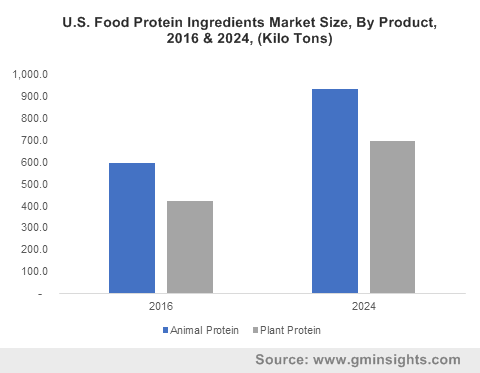Plant-based food protein ingredients market to witness an exponential growth graph over 2017-2024, segment to register 6.5% CAGR
Publisher : Fractovia | Published Date : 2018-05-21Request Sample
Food protein ingredients market has lately witnessed a profitable trajectory, pertaining to the changing relationship of consumers with food due to increasing urbanization and greater disposable incomes. Taking the rapidly increasing global populace into consideration, which incidentally according to the UN, will surpass 9.5 billion, it is rather obvious that consumption patterns will undergo an eventual change. With the changes that will follow in the dietary preferences, experts anticipate food protein ingredients industry to gain significant momentum over 2017-2024.
Protein has come to be recognized as a healthy constituent in a balanced diet. Alongside, improving socio-economic factors have contributed toward a major transition in the dietary patterns of low and middle-income countries. Animal protein-based food protein ingredients industry in particular, has gained significant momentum in developing countries. In developed nations, the consumption of animal-based food protein ingredient had always been high due to economic affluence. However, due to increasing concerns about animal cruelty and the negative effects of human-induced terrestrial biodiversity loss that large-scale consumption of animal protein can cause, plant-based food protein ingredients industry has been brought to prominence in the advanced economies.
U.S. Food Protein Ingredients Market Size, By Product, 2016 & 2024, (Kilo Tons)

Fruits and vegetables have witnessed a renewal of interest in consumption as various health regulatory bodies around the world have emphasized the importance of including these ingredients in daily diet. A study showed that 60% of American consumers between the ages of 15 and 70 are trying to cut back on their dependence on meat-based products while 17% are eating a predominantly plant-based diet. Experts observed that such behavior is not actually about rejecting meat consumption but about increasing the amount of fruit and vegetable consumption as suggested by health authorities.
As protein is viewed as one of the indispensable parts of a diet, consumers are looking to keep their protein intake unaffected by consuming more plant-based proteins. Detecting such a trend, food protein ingredients industry players are leaning towards bringing products to the market that source their protein content from plants but are as tasty as foods sourced from animal protein. Plant-based meat producers like Beyond Meat and Impossible Burger have already been producing palatable plant-based proteins. As per estimates, plant-based food protein ingredients industry share will increase at a rate of 6.5% over 2017-2024.
However, it should be observed that plant-based food protein ingredients market still has a long way to go before it becomes mainstream. Given that the prioritized reasons for consumption of protein include weight management, muscle development, appetite management and energy boosting, a significant percentage of the global population strongly believe in the consumption of animal protein. This factor would rather overtly boost animal-based food protein ingredients market size, leading to a target valuation of 3.25 million tons of consumption by 2024. In the United States, even with the rising trends of the masses turning vegetarian and vegan, the demand for animal-based food outstrips supply. Evidently, animal-based food protein ingredients industry is making significant profits in the region, as high demand facilitates a cost competitive market, something that cannot be matched by a high-quality plant-based food protein ingredients industry that is still too exorbitant for some consumers.
No matter what the source is and in what form protein is consumed, healthcare experts universally acknowledge its importance as essential amino acids go a long way in healing wounds, developing muscle tissue, healthy and bright skin and improvement of cognitive and digestive functions. Also, avoidance of protein can lead to weight gain in some cases as people end up consuming more carbs in a bid to compensate for lost protein and end up gaining weight instead. With scales tipping in the favor of consumption of adequate protein for a healthy lifestyle, food protein ingredients industry is expected to surpass $29 billion by 2024.